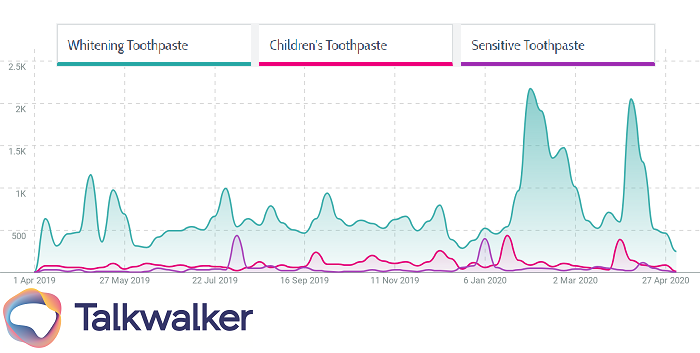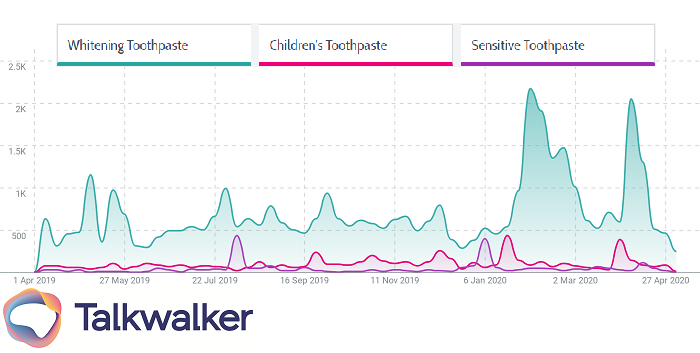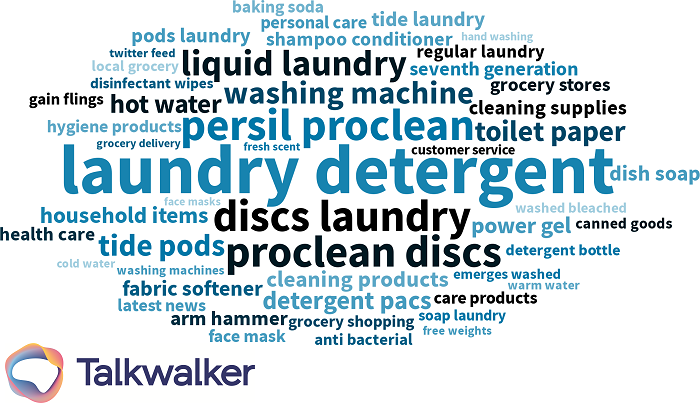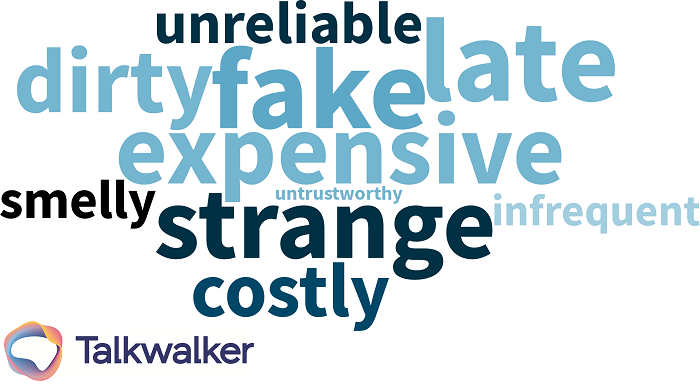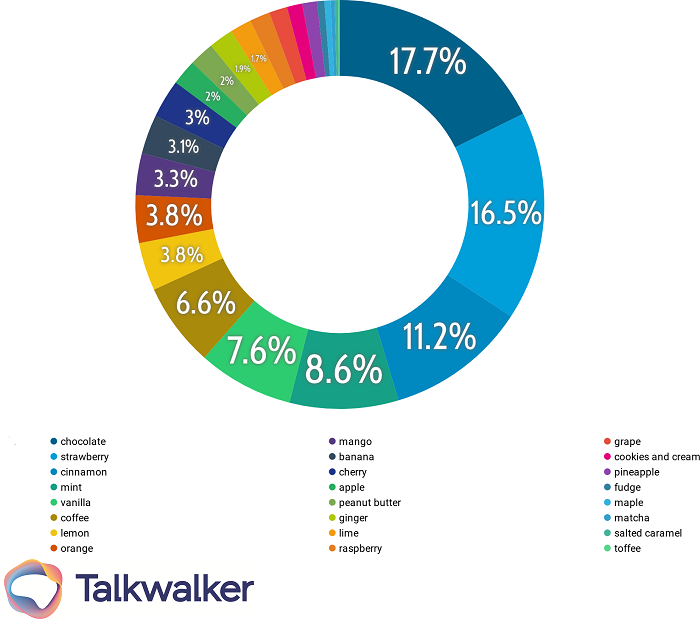Download our campaign playbook
What is a brand category?
A category is how your consumers label your brand. I know, you think your brand is one of a kind that defies labeling. But that’s what you think. Shoppers think differently. They’re looking for easy to understand ways to compartmentalize the brands they come across day-to-day.
You can often segment into categories and subcategories, to find your niche. Dental care could be a category, divided once into toothpaste, mouthwash or floss, and again, into whitening, sensitive, children’s, etc.
Quick Search graph showing the mentions of various toothpaste subcategories over 13 months. At present whitening toothpaste (green) is in huge demand.
You shouldn’t look to break the mold here. Consumers find categorization reassuring. If they can’t identify the use of your product, how it will fit into their lives or replace an existing product they use, then could be put off buying it.
Category insights definition
A category insight is a valuable piece of information that gives you knowledge of your market that your competitors don’t have.
By analyzing market trends and data, you focus on what motivates your consumers within your category, either practically and emotionally, to buy your product. This information gives you an actionable insight - not just knowledge, but knowledge you can do something with - to help identify growth avenues for the brand. Or how your brand can disrupt the industry to take more than its fair share of market.
Why conversational intelligence is vital for obtaining category insights
Category insights rely on consumer behavior intelligence. Understanding the motivations, desires, and needs of your customers. Whilst consumer research will help you gain these actionable insights, social listening is readily available for real time results.
By combining reviews, social data sources, customer feedback, conversations on blogs and forums, you get a wide overview of how consumers discuss your product. Which will provide you with a deeper understanding of your category, and the all important category insights you need. Ultimately, consumer insights lead to category insights.
Defining your category
When defining your category, you have to understand the consumer mindset, to ensure you’re positioned correctly. If you make healthy snack food, do you want to find your products on the health food aisle or the snack aisle? That decision will impact all your digital marketing and branding efforts, so it’s an important one to consider.
Traditionally, you would hypothesize a category that you think you’re in, then rely on consumer interviews to confirm that hypothesis. Using social media data sources for analysis instead, you can put that hypothesis to the billions of people online.
Look at the keywords related to laundry detergent.
The elements discussed around the ‘laundry detergent’ category
By looking at how people discuss the category, we can identify:
- Subcategories (powder, liquid, pods, discs)
- Parent categories (hygiene products, cleaning products)
- Related categories (dryer sheets, fabric conditioner)
- Key features (fresh scent, anti-bacterial)
- Category competitors (Persil, Tide, Arm & Hammer)
With this information, does the category you’ve chosen work for your brand, or does it cross into other suitable categories for you to market in?
Tracking competitors
Earlier, I said that you shouldn’t break the mold. But what if your product defies all existing categories?
In this instance, you can look to create a new category. But this requires a bigger budget, and a strong understanding of your client needs.
Look for similar categories that you will have to compete against. What use do other categories fulfill, that you brand does better? Ford did this when they introduced the car to compete against the horse & cart. Uber created a new category to compete against the taxi.
Look at these competitors, and the needs that they’re not fulfilling. These are the shopper insights you need to position your new category more effectively.
Looking at the key negative themes relating to the taxi category, a disrupter like Uber would need to offer a reliable, cost-effective, and clean service.
Identifying category trends and insights
Once you have your category cemented, you can continue analyzing conversational data, to find the trends in the industry, which will lead to your category insights. Consider your consumer motivation, both emotionally and physically, to assess:
- How are consumer needs developing?
- What’s disrupting the category?
- Are external categories impacting the demand for yours?
- Are there non-category trends that could drive category demand?
- Are there global trends that your product and services could adapt to tackle?
As with any trend analysis, it’s better to predict trends rather than adapt to them. And to do that, you need as broad a picture as possible of your consumers - social intelligence.
The best way is to think of the questions you would ask your customers, and then adapt them into queries. The data will then provide the answers. This could be:
- How can we improve the produce?
- What feature is missing?
- Could we add a new variety - flavor, style, color.
- What are we doing wrong?
- Why is our competitor better?
The list is endless. But can provide you with vital category insights.
For example, say your product development team wanted to add a new flavor in your food category. With recent food trends being anything from salted caramel to unicorn tears, how do you know what will be the most popular next? By looking at what people are demanding right now.
Tell me what’s your flavor - the flavors people said they were “loving the taste of” in one week
The ever popular chocolate and strawberry are top. But next up are cinnamon and mint. Those could be the next big flavor category insights your product needs.
Discover your category insight
Category insights are key for taking the top spot. And with social intelligence, they make data-driven decision making quick and easy. You just need to discover them for yourself. Our campaign playbook includes more examples of insights gathered from social data, to help you understand your industry, category and consumers better.

